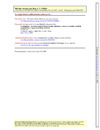Identificador persistente para citar o vincular este elemento:
https://accedacris.ulpgc.es/jspui/handle/10553/6567
| Campo DC | Valor | idioma |
|---|---|---|
| dc.contributor.author | Amann, Markus | - |
| dc.contributor.author | Calbet, Jose A. L. | - |
| dc.contributor.other | Calbet, Jose A | |
| dc.date.accessioned | 2011-11-02T02:31:00Z | - |
| dc.date.accessioned | 2018-03-08T13:10:47Z | - |
| dc.date.available | 2011-11-02T13:40:02Z | - |
| dc.date.available | 2018-03-08T13:10:47Z | - |
| dc.date.issued | 2008 | - |
| dc.identifier.issn | 8750-7587 | - |
| dc.identifier.uri | https://accedacris.ulpgc.es/handle/10553/6567 | - |
| dc.description.abstract | During exercise, fatigue is defined as a reversible reduction in force- or power-generating capacity and can be elicited by central and/or peripheral mechanisms. During skeletal muscle contractions, both aspects of fatigue may develop independent of alterations in convective O(2) delivery; however, reductions in O(2) supply exacerbate and increases attenuate the rate of accumulation. In this regard, peripheral fatigue development is mediated via the O(2)-dependent rate of accumulation of metabolic by-products (e.g., inorganic phosphate) and their interference with excitation-contraction coupling within the myocyte. In contrast, the development of O(2)-dependent central fatigue is elicited 1) by interference with the development of central command and/or 2) via inhibitory feedback on central motor drive secondary to the peripheral effects of low convective O(2) transport. Changes in convective O(2) delivery in the healthy human can result from modifications in arterial O(2) content, blood flow, or a combination of both, and they can be induced via heavy exercise even at sea level; these changes are exacerbated during acute and chronic exposure to altitude. This review focuses on the effects of changes in convective O(2) delivery on the development of central and peripheral fatigue. | en |
| dc.language | eng | es |
| dc.relation.ispartof | Journal of Applied Physiology | es-ES |
| dc.source | Journal Of Applied Physiology[ISSN 8750-7587],v. 104 (3), p. 861-870 | es |
| dc.subject | 241106 Fisiología del ejercicio | es |
| dc.subject.other | Fatigue | es |
| dc.subject.other | Exercise | es |
| dc.subject.other | Performance | es |
| dc.title | Convective oxygen transport and fatigue | es |
| dc.type | info:eu-repo/semantics/review | es |
| dc.type | info:eu-repo/semantics/review | es |
| dc.type | Article | es |
| dc.identifier.doi | 10.1152/japplphysiol.01008.2007 | |
| dc.identifier.scopus | 41549169559 | - |
| dc.identifier.isi | 000253822900038 | |
| dcterms.isPartOf | Journal Of Applied Physiology | |
| dcterms.source | Journal Of Applied Physiology[ISSN 8750-7587],v. 104 (3), p. 861-870 | |
| dc.contributor.authorscopusid | 55546373900 | |
| dc.contributor.authorscopusid | 7004323423 | |
| dc.identifier.crisid | 475 | - |
| dc.identifier.eissn | 1522-1601 | - |
| dc.description.lastpage | 870 | |
| dc.description.firstpage | 861 | |
| dc.relation.volume | 104 | |
| dc.investigacion | Ciencias de la Salud | es |
| dc.rights.accessrights | info:eu-repo/semantics/openAccess | es |
| dc.type2 | Reseña | es |
| dc.identifier.wos | WOS:000253822900038 | - |
| dc.contributor.daisngid | 5009 | |
| dc.contributor.daisngid | 90295 | |
| dc.identifier.investigatorRID | H-6693-2015 | |
| dc.contributor.wosstandard | WOS:Amann, M | |
| dc.contributor.wosstandard | WOS:Calbet, JAL | |
| dc.date.coverdate | Marzo 2008 | |
| dc.identifier.ulpgc | Sí | es |
| dc.description.jcr | 3,658 | |
| dc.description.jcrq | Q1 | |
| dc.description.scie | SCIE | |
| item.fulltext | Con texto completo | - |
| item.grantfulltext | open | - |
| crisitem.author.dept | GIR IUIBS: Rendimiento humano, ejercicio físico y salud | - |
| crisitem.author.dept | IU de Investigaciones Biomédicas y Sanitarias | - |
| crisitem.author.dept | Departamento de Educación Física | - |
| crisitem.author.orcid | 0000-0002-9215-6234 | - |
| crisitem.author.parentorg | IU de Investigaciones Biomédicas y Sanitarias | - |
| crisitem.author.fullName | López Calbet, José Antonio | - |
| Colección: | Reseña | |
Citas SCOPUSTM
234
actualizado el 08-jun-2025
Citas de WEB OF SCIENCETM
Citations
228
actualizado el 12-ene-2026
Visitas
106
actualizado el 10-ene-2026
Descargas
524
actualizado el 10-ene-2026
Google ScholarTM
Verifica
Altmetric
Comparte
Exporta metadatos
Este elemento está sujeto a una licencia Licencia Creative Commons

